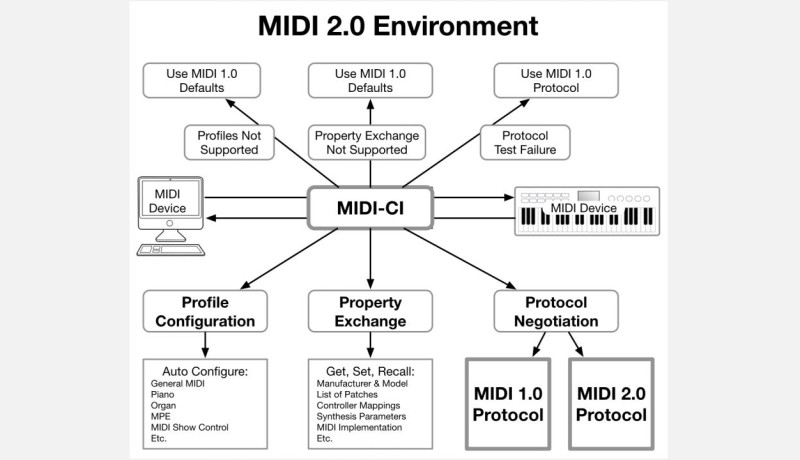MIDI finally gets a major update with the announcement of MIDI 2.0
January 21, 2019
on
on

About 35 years after its introduction MIDI (Musical Instrument Digital Interface), the communication protocol that lets musical instruments talk to each other, has finally gotten a major upgrade with the announcement of MIDI 2.0 this month. Although v2.0 introduces many new features, it is 100% backwards compatible with v1.0.
Currently available only to MMA and AMEI members the specification for the new standard will be available for download soon (hopefully), and only then will we know what exactly MIDI 2.0 is all about. One thing is for sure, however: it will add a lot of complexity.
Illustration: MIDI Manufacturers Association (MMA)
Available for download soon
A revision of the MIDI standard has been under discussion for some fifteen years and was required to keep up with ever evolving technology. Many modern musical instruments and other compatible devices use hard- and software with communication capabilities way beyond what is possible with MIDI. The new standard developed by the MMA provides a framework for extended networking features like auto discovery, new DAW (Digital Audio Workstation) and web integrations, extended resolution, increased expressiveness, and tighter timing.Currently available only to MMA and AMEI members the specification for the new standard will be available for download soon (hopefully), and only then will we know what exactly MIDI 2.0 is all about. One thing is for sure, however: it will add a lot of complexity.
MIDI-CI
What we do know is that MIDI 2.0 introduces a sort of negotiation phase at connection time, the MIDI Capability Inquiry (MIDI-CI). During this phase the MIDI 2.0 device tries to find out what is on the other side of the cable. When the remote device does not respond correctly to messages sent by the MIDI 2.0 device, the latter will assume it is talking to a MIDI 1.0 device. Doing things this way ensures compatibility with the 30+ years of legacy devices currently in use.New MIDI connector
Note that in 2018 the MMA also released a “Letter of Agreement for Recommended Practice” for a new MIDI connector: the TRS connector. TRS stands for Tip-Ring-Sleeve and refers to jack connectors commonly used for headphones and other audio cables. The letter of agreement suggests using small 2.5-mm jack plugs instead of the traditional bulky 5-way DIN connectors when space is limited. The tip connects to pin 5, the ring to pin 4 and the sleeve to pin 2.Illustration: MIDI Manufacturers Association (MMA)
Read full article
Hide full article


Discussion (0 comments)